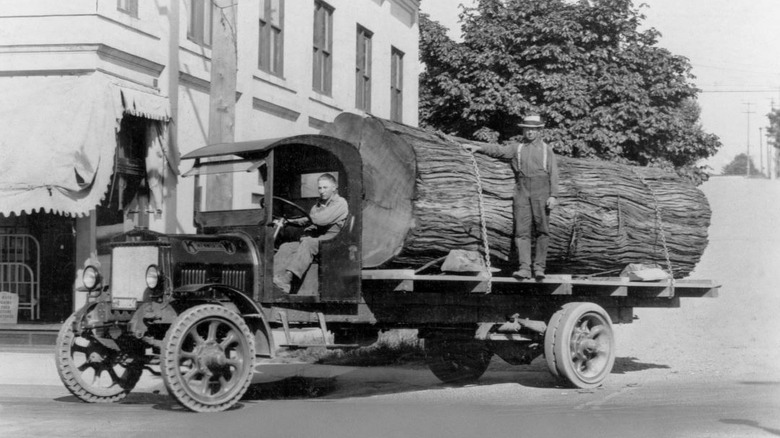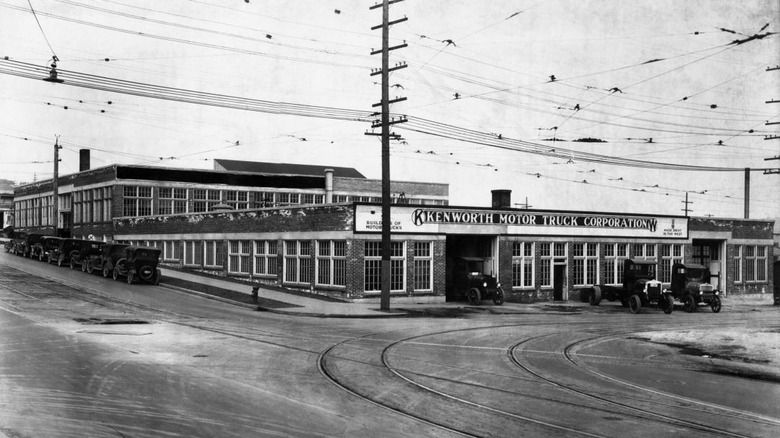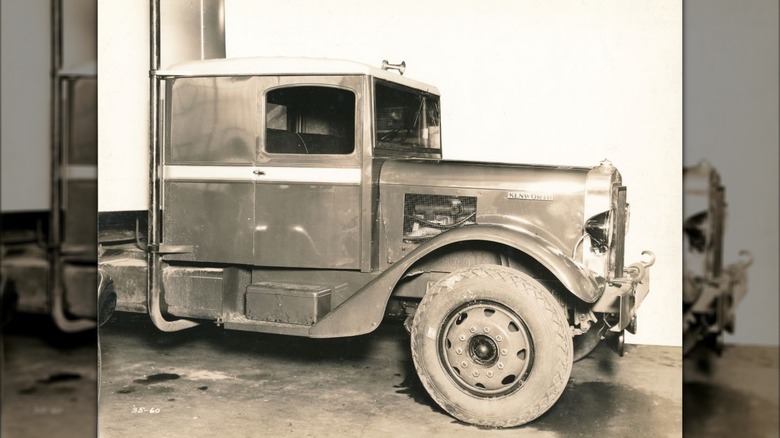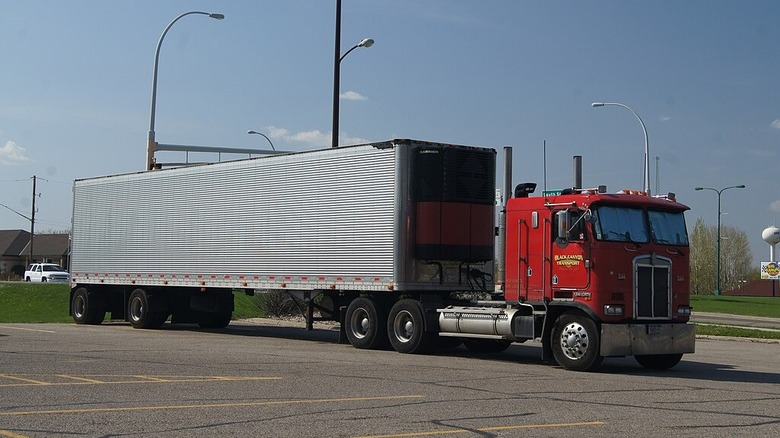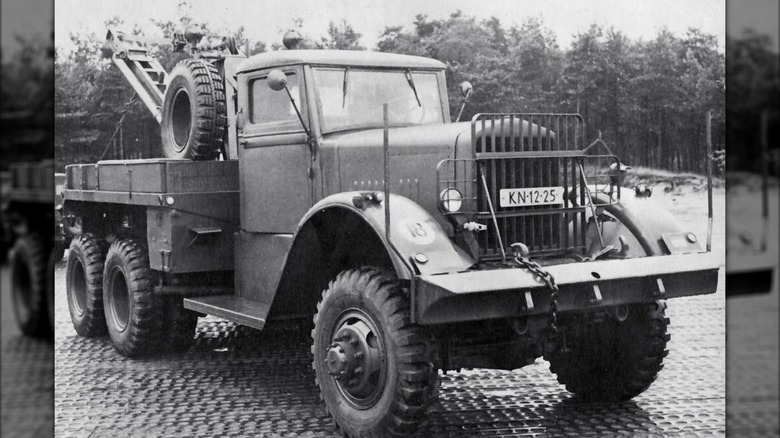How Kenworth Became Synonymous With American Trucking
It may sound unrealistic, but nearly every new heavy-duty, semi-truck (Class 8) sold in the United States (99.9% of them, in fact) comes from just seven brands, which in turn are owned by only four companies. A Class 8 truck is defined as anything with a gross vehicle weight (GVW) over 33,001 pounds, and aside from semi-trucks, includes vehicles like cement mixers, dump trucks, tour buses, and fire trucks. The seven aforementioned brands are Freightliner, Peterbilt, International, Volvo, Mack, Western Star, and last but not least. Kenworth (which may have been the inspiration for Optimus Prime).
Created by Alexander Winton (founder of the Winton Motor Carriage Company), the first semi appeared on the roads in 1898. Winton attached a flat-bed wagon with rear axles to one of his existing autos to make a semi-truck that could haul cars. Well, a single car at least. Once the masses realized they could use one vehicle to haul another (along with goods), the trucking industry never looked back in the rearview mirror.
And although Mack Trucks (which is not owned by Ford by the way) may be the oldest semi-truck manufacturer in the U.S., and the market is currently dominated by Freightliner which holds approximately 36% of the market share (making it the most popular brand in the U.S.), Kenworth has a very long and storied history in the U.S. that goes back over 100 years.
Before Kenworth there was Gersix
The Kenworth story starts not with the two men who founded the company – Edgar K. Worthington and Captain Frederick Kent — but with two brothers, George and Louis Gerlinger, Jr. These siblings owned a car and truck dealership in Seattle, Washington, called Gerlinger Motor Car Works.
In 1914, they decided to purpose-build a truck of their own design, powered by a six-cylinder engine, at a time when most "truck" engines had only four cylinders. What's more, the cab was made from steel instead of wood framing. The vehicle was known as the "Gersix," a combination of the brother's last name and the number "six" to designate that it had six cylinders, and was released in 1915. It proved to be the ideal truck for the logging industry, which dominated the Pacific Northwest.
The following year (1916) the Gerlingers moved their company to Tacoma, Washington, where it was purchased by Edgar K. Worthington and his business partner Captain Frederick Kent in 1917. They were also interested in providing trucks capable of moving loads of heavy timber over the abysmally muddy and rutted "roads" used by the logging companies. Gearsix continued to build their six-cylinder gasoline trucks, and when the Captain retired in 1919, his son Harry stepped in and replaced him. The men decided to reincorporate the company and move it to Seattle, Washington, and in a nod to the Gerlingers, they combined their last names to create Kenworth Motor Truck Company.
Customization and innovation became key
A mere two months after becoming Kenworth in January 1923, the company was producing newly badged trucks, and in that first year it made 78 gasoline-powered trucks. By 1925, they had become so popular, they were making almost two complete trucks every week. In addition to adding five new models to their lineup — powered by a Buda four-cylinder gas engine with varying hauling capabilities between 1- and 5 tons — customization and innovation became an integral part of the "Kenworth way." The ability to integrate a customer's specific needs wherever possible allowed Kenworth to prosper more.
In 1927, Harry Kent became President of the company, and built a new factory in Seattle (a building they would stay in until 1946) and Canada (to avoid import duties), and the first Canadian-built 3-ton J-6 rolled off the line later that same year. Meanwhile, the Seattle plant, which was only 120 feet by 240 feet (including office space, service department, and showroom), allowed them to build three new trucks a week with a capacity of 50 per month. The top-of-the-line trucks leaving this plant were powered by a 78 hp six-cylinder gas engine with a seven-speed transmission.
Then, on a Thursday in October 1929, the stock market crashed, which subsequently sent the world into the Great Depression. Kenworth managed to avoid the ultimate fate of going out of business, but production was impacted. By the early 1930s, the company was making just 250 trucks a year.
The Great Depression and the Motor Carrier Act
With ever-increasing pressure to stay afloat amidst the Great Depression, Kenworth branched out into state government business and in 1932 started making fire trucks. With their already established ability to customize big rigs to suit individual customer needs, they were able to follow the exact same blueprint and make trucks specifically for individual fire stations, something other companies simply couldn't provide.
Starting in 1933, Kenworth became the first American trucking company to provide several firsts in the industry. A four-cylinder, 100 hp, HA-4 Cummins diesel engine — complete with vertical exhausts (also a first in the industry) — became standard equipment. They also offered an integrated sleeper cab, which for the first time provided a built-in area for the driver to stretch out and sleep. Kenworth would develop a separate sleeper cab in 1947.
The Motor Carrier Act, introduced in 1935, allowed the Interstate Commerce Commission (ICC) to establish federal regulations over the trucking and bus industries, thanks in no small part to the steep impact (decline) these new conveyances were having on the railroad industry. It created routes and fixed rates to tame what was seen as a wholly unregulated commercial enterprise with the hopes of making it financially reasonable, reliable, and safe. Restrictions on the size and weight of trucks and trailers resulted in each state having different limits based on how old its roads and bridges were at the time, all of which led to the building of weigh stations to enforce these new regulations.
Kenworth engineers really did wear muddy boots
The Motor Carrier Act was yet another opportunity for Kenworth to innovate. They went back to the drawing board and started using aluminum to make the cabs (as well as the hubs and, eventually, bumpers), built much lighter four-spring and torsion bar rear suspensions, introduced hydraulic brakes, and offered the option of having six wheels.
In 1936, Kenworth unveiled the Model 516, the first ever cab-over-engine truck (COE). After the Motor Carrier Act, New Mexico mandated a weight per axle restriction, and trucks couldn't be more than 45 feet long, so lopping off the front end shrank a truck's overall length considerably. All of these new innovations led to more trucks hitting the road and the eventual development of transcontinental runs.
The following year, Harry Kent died from a heart attack at the age of 55, and Philip Johnson (former President of Boeing Airplane Company and United Airlines) took his place as President. During the next few years, internal strides were made that ingrained the Kenworth brand further into the American landscape. Engineers routinely went into the field to see firsthand how the vehicles they created were actually performing in the real world. This proactive move allowed them to see the problems as they occurred and fix them in almost real time, giving everyone in the production stream — from concept to final sale — a better understanding of how to build a more reliable truck. Thus, the iconic "Kenworth engineers wear muddy boots" motto was born.
Kenworth lived because it constantly innovated (and still does)
When World War II broke out, the military needed something to retrieve broken and disabled tanks, so Kenworth shifted gears again and created a 4-ton, six-wheeled, M-1 "Wrecker" equipped with heavy-duty cranes, winches, cutting/welding equipment, and floodlights. These were built at a new plant at the fairgrounds in Yakima because Kenworth needed the main Seattle plant to make bomber nose-cone assemblies and other components for the B-17 "Flying Fortress" and the B-29 "Super Fortress" for the war effort. This provided insight into using aluminum extrusions and building aluminum sub-assemblies, which they would later use to make the trucking industry's first aluminum frame rail.
Philip Johnson (Kenworth's President) died in 1944, and Pacific Car and Foundry (PACCAR) made an offer Kenworth couldn't refuse in 1945, turning them into an owned subsidiary. A south Seattle plant was built with a chain-driven assembly line that allowed them to make trackless trolleys, inner-city buses, and dump trucks, while the primary facility focused on semi-trucks. In 1947, decals on every Kenworth truck began proclaiming "Everything You Eat, Wear, or Use Comes by Motor Truck," promoting the trucking industry and helping make Kenworth a household name.
Sales exploded as the company branched out into South America, Africa, and the Middle East, and by 1950, it had 27 distribution locations outside the U.S. (accounting for 40% of all sales) and 30 models (not including customs) running across the American countryside. Kenworth built its 10,000th truck in '51, 25,000th by '62, and 1 millionth in 2014, and is still innovating today.

